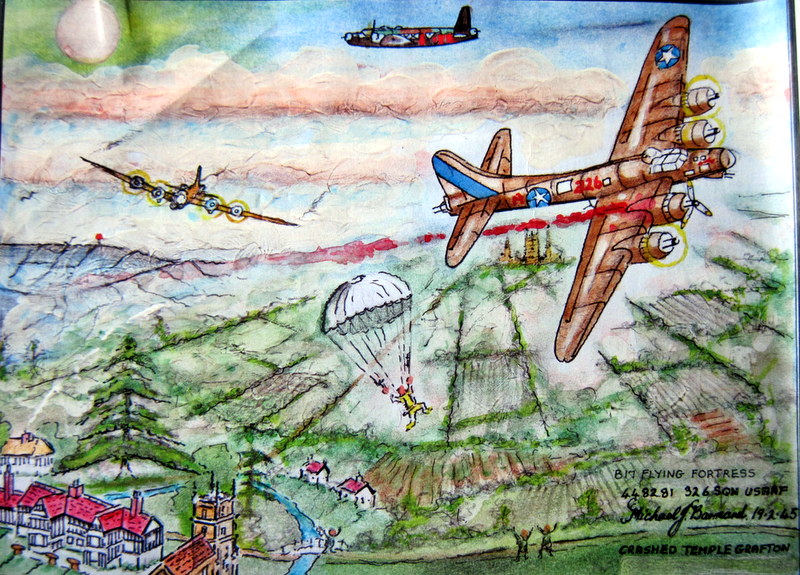This article has been compiled as a tribute to Badsey artist, Michael Barnard, who died on 13th March 2020, aged 91. Michael drew the picture below and wrote some of the accompanying details which appeared in an article in the Vale Magazine, No 203, October 2013.

On the morning of 19th February 1945, an American aircraft got into difficulties over Wickhamford and the crew had to parachute to safety. The reason for the bale-out of the crew was because an engine was on fire. The aircraft was a B17 Flying Fortress with nine crew and belonged to 326 Bomb Squadron, 92nd Bomb Group, USAAF. The bomber – 44-8281 – had taken off from the airfield at RAF Podington, in Bedfordshire, and the crew were 2Lt John E. Deegan; 2 Lt Claw W Baker Jr; F/O David Livis; Sgt John V. Mendes; Sgt Keith E. Leevit; Sgt Joseph T. Doyle; Sgt Claud N. Russell Jr; Sgt Lloyd S. Desant and Sgt John J. Jonas.
As the aircraft got into difficulties, a Wellington Bomber, flown by F/Lt Meredith, took off from Honeybourne to observe the stricken American plane. He stayed well away, as the bomber was fully loaded with bombs. All of the crew eventually safely abandoned the aircraft and it finally crashed into the grounds of Temple Grafton Court, Warwickshire. After the impact at Temple Grafton, one of the engines of the plane became detached and landed very close to Temple Grafton church. The Horniblow family, of ‘Rose Bank’, were living in the village when the plane crashed. As it did so, it ploughed into a row of elm trees and cut them off as if breaking matchsticks. It took the glass out of the windows of their house (and probably many other houses in the village) and the part of the house facing the blast was pockmarked with shrapnel. The crash site was close to Temple Grafton village hall. The school was also very close by, so that had a lucky escape. At one time, George Horniblow kept a piece of shrapnel as a souvenir!
One of the airmen landed near the Church of St John the Baptist, Wickhamford. A number of villagers gathered around to help him and some of the Land Army girls, billeted at Wickhamford Manor, decided that the parachute would make lovely underwear! Michael Barnard was one of the people who ran to help and towards the end of his life he produced the drawing above to illustrate the event.
Another airman landed in Whitfurrows close to where market gardener Fred Mason was working on his land. He asked Fred 'which way has the plane gone as it is loaded with bombs'. Unfortunately, the names of the airmen who landed in Wickhamford have not been recorded.
The damage done in Temple Grafton was reported upon in the Warwick and Warwickshire Advertiser of 23rd March 1945. A surveyor had stated that ten Council houses had received damage to walls, ceilings and windows as a result of the crash. The necessary repairs were estimated to cost £76 18s 4d and that a claim had been lodged with the War Damage Commission. (This sum is equivalent to about £2,500 today.)
Tom Locke and Val Harman – March 2020
Footnote – Originally, B17 bombers had a crew of nine airmen, by February 1945 this had been reduced to eight. This was done by removal of both waist gunners, but there were complaints that the radio operator was often too busy to go back to the waist and operate one of the guns, leaving the plane vulnerable to attack out of range of the ball or tail turret gunners. At the time of the incident recorded here, there were again nine members of the crew. Thanks are due to Stewart Lanham, who contacted the authors, in January 2024, to provide these details.
